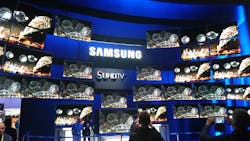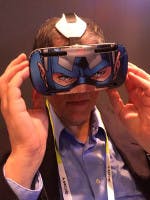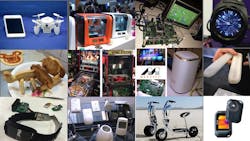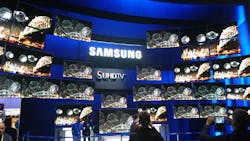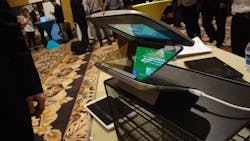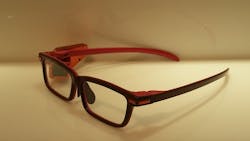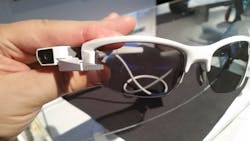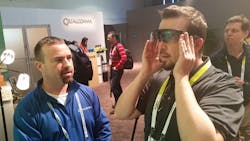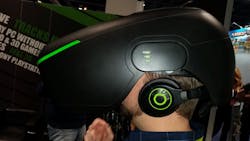The 2015 Consumer Electronics Show was as busy as ever where one could find the latest in wearable tech, curved OLED UHD screens, 3D printers and flying drones. There was plenty on display for the public and even more hiding behind closed doors. I got a chance to check out some of both. Of course, not all of it. That would take many weeks and we had less than one.
Last year was the introduction of the 4K or UHD (Ultra HD) but they were everywhere this year (see “Ultra HD Displays Are The Next Big Thing”). There is finally more content available although don't count on a massive wave of real time 4K content. What is available tends to be streaming movies from providers such as Netflix, Amazon and NanoTech Entertainment. We will continue to have low res SD, 720p and 1080i content upscaled for quite a while. Investment in 4K and higher cameras is still in progress but it will come, eventually.
Luckily I had Curtis Ellzy of Engineering TV with me and we (see CES 2015 on Engineering TV). The videos cover the range of what we saw but I am going to concentrate on just a portion in this article.
The displays keep getting thinner but the electronics still make the displays rather thick. In fact, the electronics tend to us up more depth although they do not take up the entire back area.
OLED technology was the big thing this year. Massive OLED displays are still pricey but much more affordable than last year. They look great and are the technology to beat. Of course, LCD displays with quantum dot support are delivering wider spectrum backlighting (see “Q&A: Cadmium-Free Quantum Dots Offer Low-Risk Benefits of True Color”).
What was impressive were various demos of 3D displays that do not require glasses. These were not the tiny, washed out screens of yore. They were as large as most of the large screen UHD displays. The 3D effect is noticeable and the viewing angle has been increased but it is not quite up to the glasses-based 3D of which there was still some, detractors not withstanding.
There was a lot of 3D technology floating around CES even though 3D has not driven HDTV sales. Super3D had an interesting popup 3D display that foregoes glasses (Fig. 2). It uses a tablet to project images on a mirrored glass plate. An eye tracking system helps improve the effect.
I did not see a lot of Google Glasses around CES but there were plenty of competitors with an array of products or prototypes on display. Toshiba's Toshiba Glass (Fig. 3) projects an image onto the back of the lens instead of using a plastic mirror in flexiglass.
Another concept system was Sony's Smartglasses (Fig. 4). These clip-ons look more like Google Glass using the same type of imaging system. The approach could be used for sports or leisure. You need a pair of glasses if you don't already have a pair but it provides more flexibility and does not have to be used all the time.
Not everyone was chasing the general Google Glass field. Aero Glass is targeting pilots with its augmented reality system (Fig. 5). The demo presents a pilot's checklist. It is not quite comparable to the heads-up display in an F-35 Joint Strike Fighter pilot's helmet but it could be extremely useful in replacing the paper or tablet-based checklist needed for every flight.
I got to try out Samsung's Gear VR that uses the Note 4 and was on my holiday gift list (see “Real Techie Holiday Picks From Lab Bench”). It works although it does not track as nicely as the Oculus Rift that incorporates more advanced tracking. The Gear VR is a lot less expensive and useful if you have a Note 4. I was hoping they would have a version for the Samsung Galaxy S5 that I have but no luck. Also, the line for testing out the latest Oculus Rift was a bit long. It was the newer, hi-res version that is more expensive and worth looking at.
We did check out Beverly Hills 3D's technology called 3D Head (Fig. 6). The demo version used a projector but it was supposed to have a 3D tablet that was also at the booth. The prototype plastic unit was a bit heavier that what the final version should be. It is an interesting alternative that may be worth another look at next year's CES. Like many demos at the show, it could have used a little more polish.
Finally we got Whooshed (Fig. 7) while wandering through the North hall looking for automotive tech. It is the “Next Generation Screen Cleaner.” It did a number on my Samsung S5 making it look like new and it has remained so since I have returned from CES. In theory its polymer-based formula builds up over time to help resist dust and smudges. That is not something I can easily test nor did I have a way to test their other cleaning claims but it would be an interesting science project.
I was going to add some more about other things I saw at CES like 3D printers and flying drones but it will have to wait. This is getting too long as is and it only touches on image technology. Check out Engineering TV (playlist link to be added) for some of the videos we shot at the show. I will also add more links to article like Wearable Tech at CES Unveiled 2015 that will address these and other items at the show. There was a lot of transportation related tech I saw as well.
About the Author
William Wong Blog
Senior Content Director
Bill's latest articles are listed on this author page, William G. Wong.
Bill Wong covers Digital, Embedded, Systems and Software topics at Electronic Design. He writes a number of columns, including Lab Bench and alt.embedded, plus Bill's Workbench hands-on column. Bill is a Georgia Tech alumni with a B.S in Electrical Engineering and a master's degree in computer science for Rutgers, The State University of New Jersey.
He has written a dozen books and was the first Director of PC Labs at PC Magazine. He has worked in the computer and publication industry for almost 40 years and has been with Electronic Design since 2000. He helps run the Mercer Science and Engineering Fair in Mercer County, NJ.
- Check out more articles by Bill Wong on Electronic Design
- Bill Wong on Facebook
- @AltEmbedded on Twitter
